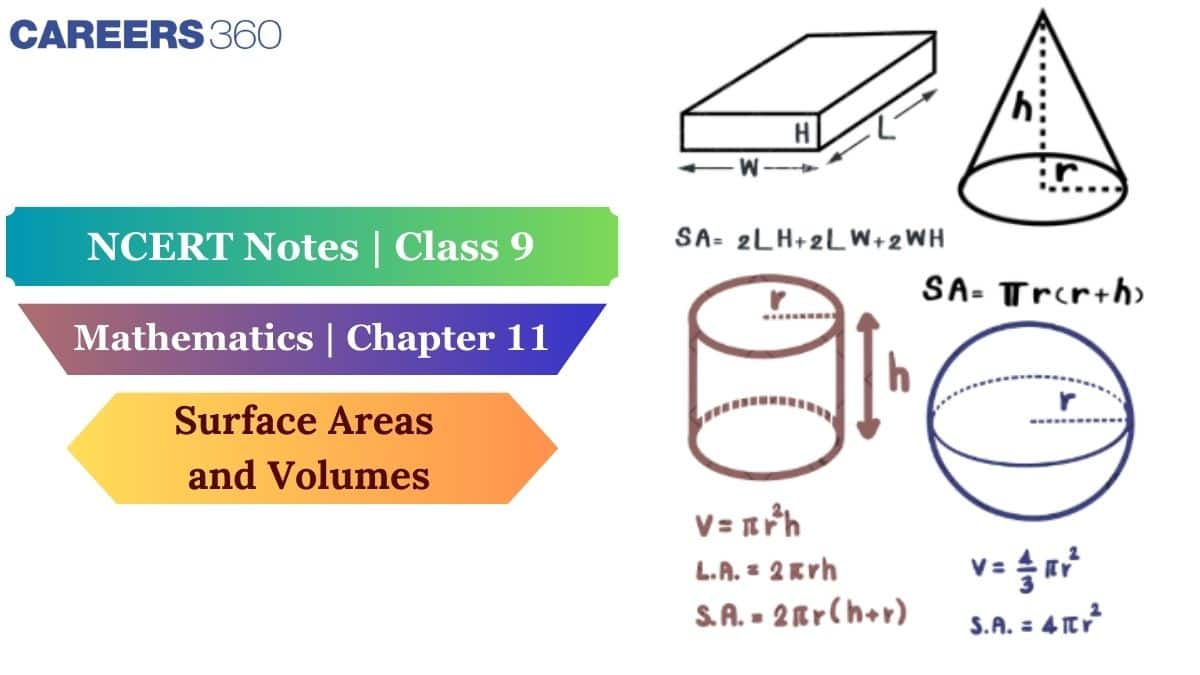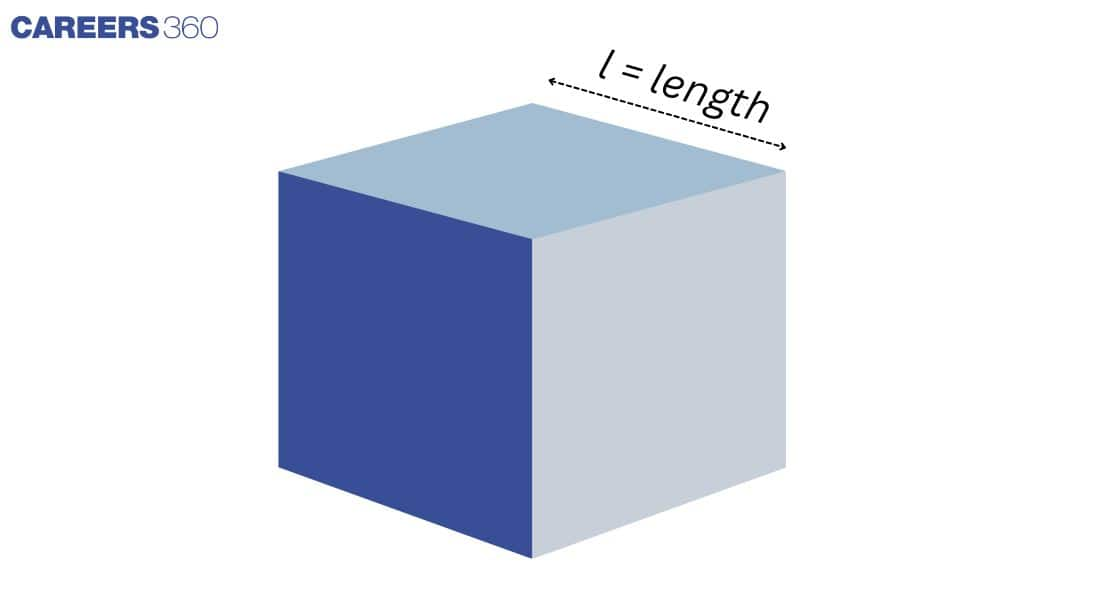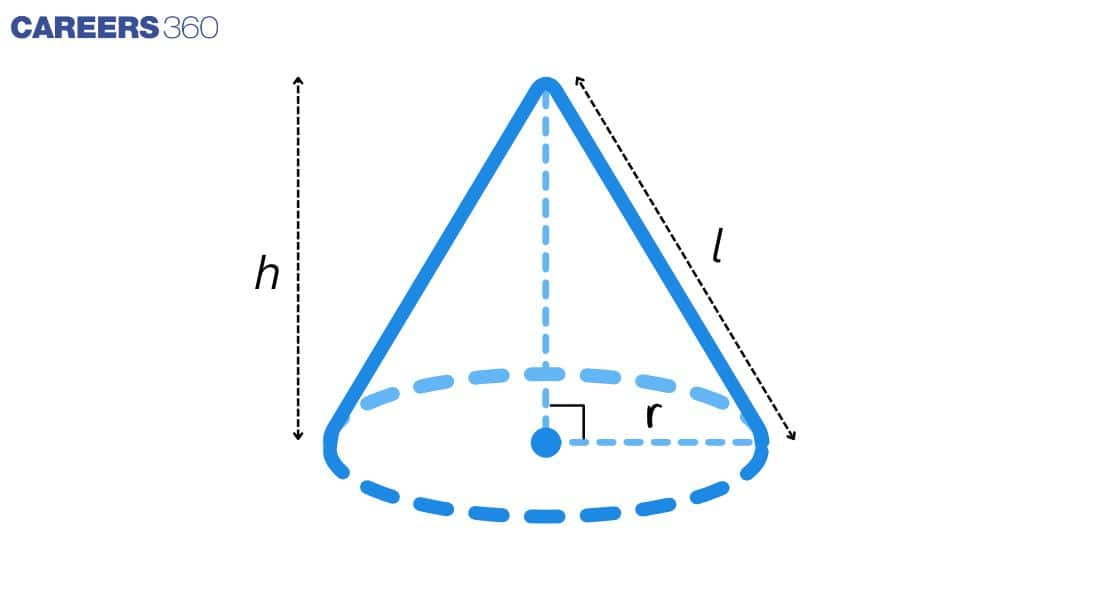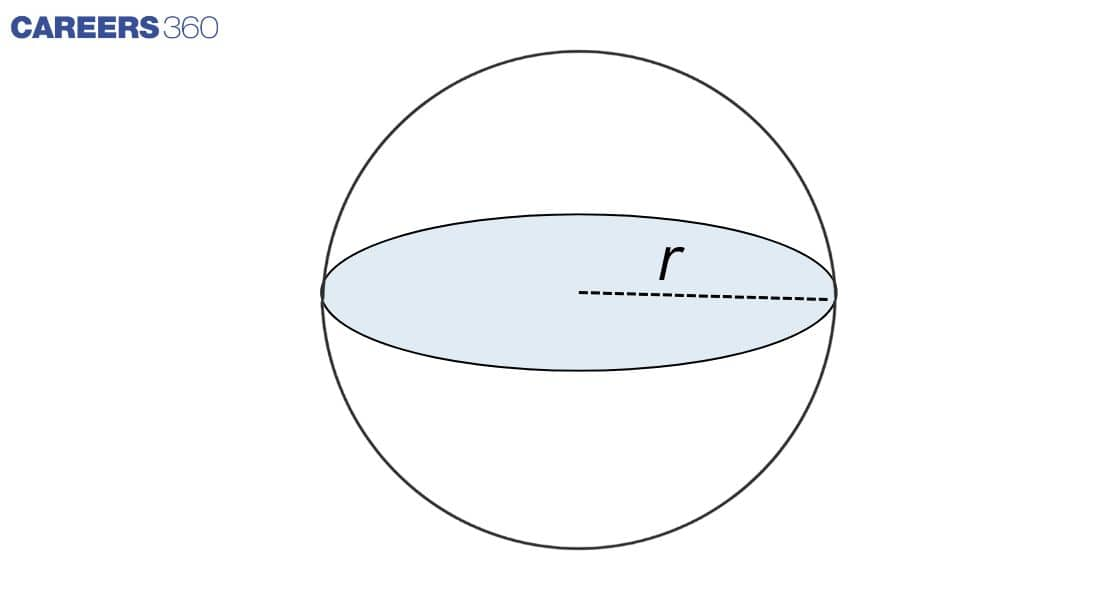NCERT Class 9 Maths Chapter 13 Notes Surface Areas And Volumes (Download PDF)
The world contains numerous three-dimensional objects, including boxes, cans, balls, and pipes. The objects possess two features: areas to measure and inner space to fill. This chapter presents methods for calculating the exterior surface area and internal volume of cubic shapes, including cuboids, cubes, and cylinders, to address practical issues such as determining wall painting requirements and calculating tank water capacity. The information provides valuable tools for examinations and serves important functions in everyday life and architectural engineering design professions. Students should use these excellent NCERT class 9th maths notes to establish foundational mathematical concepts and efficiently review key concepts of the various subjects, cones, spheres and also the hemispherical geometry.
This Story also Contains
- Class 9 Chapter 11 Surface Areas and Volumes Notes PDF – Download Free Study Material
- NCERT Notes Class 9 Maths Chapter 11 Surface Areas and Volumes
- How to Use the Surface Areas and Volumes Class 9 Notes Effectively?
- Surface Areas and Volumes Class 9 Notes: Previous Year Question and Answer
- NCERT Class 9 Maths Notes – Chapter-Wise Links

The chapter provides basic formulas which solve practical issues that include wall painting requirements and tank water capacity determination. The information provides valuable tools for examinations and serves important functions across everyday life situations and architectural engineering design professions. Students should use the excellent NCERT class 9th maths notes to establish foundational mathematical concepts. And, efficiently utilise the NCERT Notes to review key concepts of the various subjects.
Also, read,
Class 9 Chapter 11 Surface Areas and Volumes Notes PDF – Download Free Study Material
Careers360 brings you NCERT Class 9 Maths Chapter 11 Surface Areas and Volumes notes, carefully prepared by subject experts to simplify your studies and help in exams. A downloadable PDF is available — click the link below to access it.
NCERT Notes Class 9 Maths Chapter 11 Surface Areas and Volumes
Surface Area: The entire space which the external surface of an object takes up is known as the surface area of that object.
(Measured in square units, e.g., cm², m²)
Volume: The measurement of the space occupied by an object is referred to as volume.
(Measured in cubic units, e.g., cm³, m³)
Surface Area and Volume of a Cube
A cube is a cuboid with the same length, width, and height. Six surfaces, twelve edges, eight corners, and four diagonals make up a cube. Example: a dice.

Total Surface Area: 6 × (side)²
Lateral Surface Area: 4 × (side)²
Volume: (side)³
Example:
If side = 3 cm, then Volume = (side)³ = 3³ = 27 cm³
Surface Area and Volume of a Cuboid
A cuboid is a figure that is surrounded by six rectangular surfaces, with opposite surfaces equal and parallel. In a Cuboid, 12 edges and 8 corners are there. The vertex of a cuboid is each of its four corners. The diagonal of a cuboid is the line segment connecting the opposite vertices. In a cuboid, there are four diagonals. Example: a brick or a matchbox.

L = Length, B = Breadth and H = Height
Total Surface Area: 2 × (lb + bh + hl)
Lateral Surface Area: 2 × (l + b) × h
Volume: l × b × h
Example:
If l = 5 cm, b = 4 cm, h = 3 cm, then Volume = l × b × h = 5 × 4 × 3 = 60 cm³
Surface Area and Volume of a Right Circular Cylinder
A solid generated by the revolution of a rectangle around one of its sides is known as a right circular cylinder. It is a three-dimensional shape having two congruent and parallel sides. Thus, two circular and one lateral face, when combined, form a cylinder as shown in the figure. Example: a cold drink can or a water tank.

R = Radius and H = Height
Total Surface Area: 2πr(h + r)
Curved Surface Area: 2πrh
Volume: πr²h
Example:
If r = 7 cm, h = 14 cm, π = $\frac{22}{7}$,
then Curved surface area = 2πrh = 2 × $\frac{22}{7}$ × 7 × 14 = 616 cm²
Surface Area and Volume of a Right Circular Cone
A right circular cone is a solid formed when a right triangle is rotated around one of its sides (other than the hypotenuse). Thus, it contains a circular base and a curved surface that gradually decreases to a single point called the vertex. Example: an ice cream cone.

R = Radius, L = Slant Height and H = Height
Total Surface Area: Curved surface area + Base area
⇒ πrl + πr²
Curved Surface Area: πrl
Volume: $\frac{1}{3}$ × πr²h
Example:
If r = 7 cm, h = 12 cm, π = $\frac{22}{7}$,
then Volume = $\frac{1}{3}$ × πr²h
= $\frac{1}{3}$ × $\frac{22}{7}$ × 7 × 7 × 12
= 616 cm³
Surface Area and Volume of a Sphere
A sphere is the spatial area of a solid that touches a curved surface by which every point maintains an equal distance to its fixed centre. The centre point of the sphere serves as its fixed position. A sphere possesses a radius that represents the straight distance from its centre point to the surface. Example: ball

R = Radius
Surface Area: 4πr²
Volume: $\frac{4}{3}$ × πr³
Example:
If r = 21 cm, π = $\frac{22}{7}$,
then Volume = $\frac{4}{3}$ × πr³
= $\frac{4}{3}$ × $\frac{22}{7}$ × 21 × 21 × 21
= 38808 cm³
Surface Area and Volume of a Hemisphere
A plane which passes through the sphere's centre produces equal halves which correspond to each other as two separate hemispheres. Each divided part of the sphere is called a hemisphere. Example: a dome

R = Radius
Total Surface Area: 3πr²
Curved Surface Area (CSA) = 2πr²
Volume: $\frac{2}{3}$ × πr³
Example:
If r = 21 cm, π = $\frac{22}{7}$,
then Volume = $\frac{2}{3}$ × πr³
= $\frac{2}{3}$ × $\frac{22}{7}$ × 21 × 21 × 21 = 19404 cm³
How to Use the Surface Areas and Volumes Class 9 Notes Effectively?
Surface Areas and Volumes become easy when we clearly understand the formulas for cones and spheres. This chapter in Class 9 needs regular practice because most questions involve step-by-step calculation. When we revise frequently, using the right formula becomes simple, and Class 9 Maths chapter 11 notes help us do this well. Here are some more points on how these notes are important.
- First, read each formula for surface area and volume, and write it in a small notebook so we can revise it quickly.
- Practise different types of questions on cones and spheres to understand how and when each formula is used.
- Keep the NCERT Class 9 Maths chapter 11 notes beside us while solving problems to check steps and avoid calculation mistakes.
- Use the NCERT Class 9 Maths chapter 11 notes to build a strong base, because these formulas are used again in higher classes for more complex 3D shapes.
Surface Areas and Volumes Class 9 Notes: Previous Year Question and Answer
Question 1:
The radius of a right circular cylinder is thrice of its height. If the height of the cylinder is 3.5 cm, what is the volume of the cylinder?
Solution:
The height of the cylinder, $h$ = 3.5 cm
So, radius, $r$ = 3.5 × 3 = 10.5 cm
Now, the volume of the cylinder = $\pi r^2 h=\frac{22}{7}×(10.5)^2×3.5=1212.75\ \text{cm}^3$
Hence, the correct answer is 1212.75 cm³.
Question 2:
What is the volume of a cone whose base diameter is 12 cm and whose height is 21.7 cm?
Solution:
Given diameter = 12 cm
So, radius $=\frac{12}{2}=6$ cm
Height, $h$ = 21.7 cm
We know, Volume of a cone $=\frac{1}{3}\pi r^2h=\frac{1}{3}×\frac{22}{7}×(6)^2×(21.7)=818.07$ cm3
Hence, the correct answer is 818.07 cm³.
Question 3:
A metallic solid sphere has a radius of 28 cm. If it is melted to form small spheres of radius 3.5 cm, then how many small spheres will be obtained?
Solution:
The radius of a large sphere, $R$ = 28 cm
The radius of a small sphere, $r$ = 3.5 cm
Let $n$ be the number of small spheres.
The volume of the large sphere = number of small spheres × volume of the small sphere
So, $\frac{4}{3} \pi R^3 = n × \frac{4}{3} \pi r^3$
$⇒ n = \frac{R^3}{r^3} = \frac{28^3}{3.5^3}= 512$
Hence, the correct answer is 512.
NCERT Class 9 Maths Notes – Chapter-Wise Links
For students' preparation, Careers360 has gathered all Class 9 Maths NCERT notes here for quick and convenient access.
|
NCERT Notes Class 9 Maths Chapter 4 Linear Equations in Two Variables |
|
NCERT Notes Class 9 Maths Chapter 5 Introduction To Euclid’s Geometry |
|
NCERT Notes Class 9 Maths Chapter 11 Surface Areas and Volumes |
NCERT Solutions for Class 9
Students must check the NCERT solutions for Class 9 Maths and Science given below:
NCERT Exemplar Solutions for Class 9
Students must check the NCERT exemplar solutions for Class 9 Maths and Science given below:
NCERT Books and Syllabus
To learn about the NCERT books and syllabus, read the following articles and get a direct link to download them.
Courses After 12th
Applications for Admissions are open.
As per latest syllabus. Physics formulas, equations, & laws of class 11 & 12th chapters
JEE Main Important Chemistry formulas
Get nowAs per latest syllabus. Chemistry formulas, equations, & laws of class 11 & 12th chapters
JEE Main high scoring chapters and topics
Get nowAs per latest 2024 syllabus. Study 40% syllabus and score upto 100% marks in JEE
JEE Main Important Mathematics Formulas
Get nowAs per latest syllabus. Maths formulas, equations, & theorems of class 11 & 12th chapters
